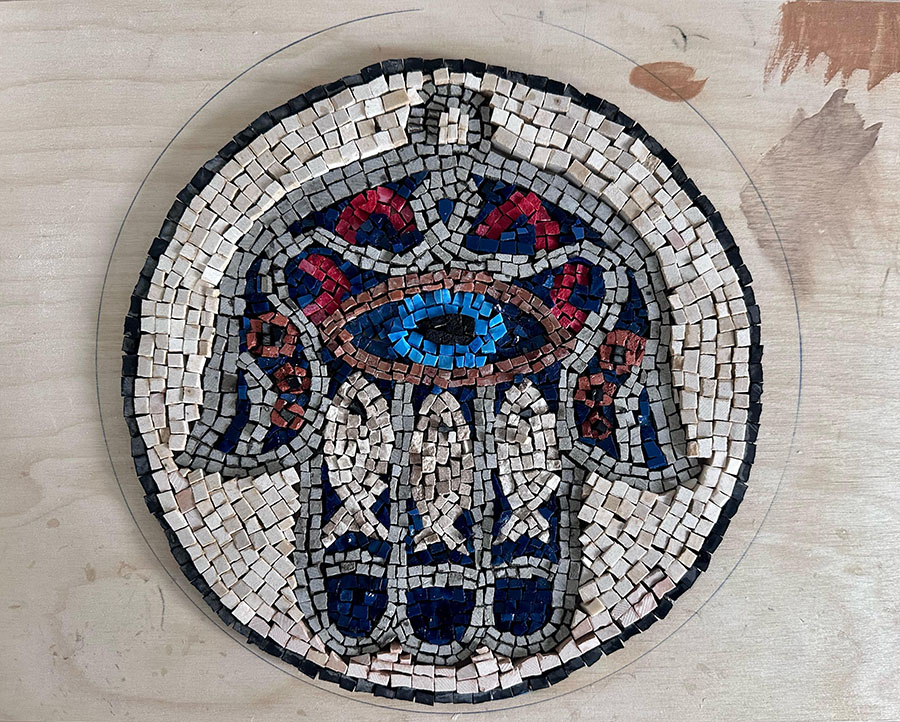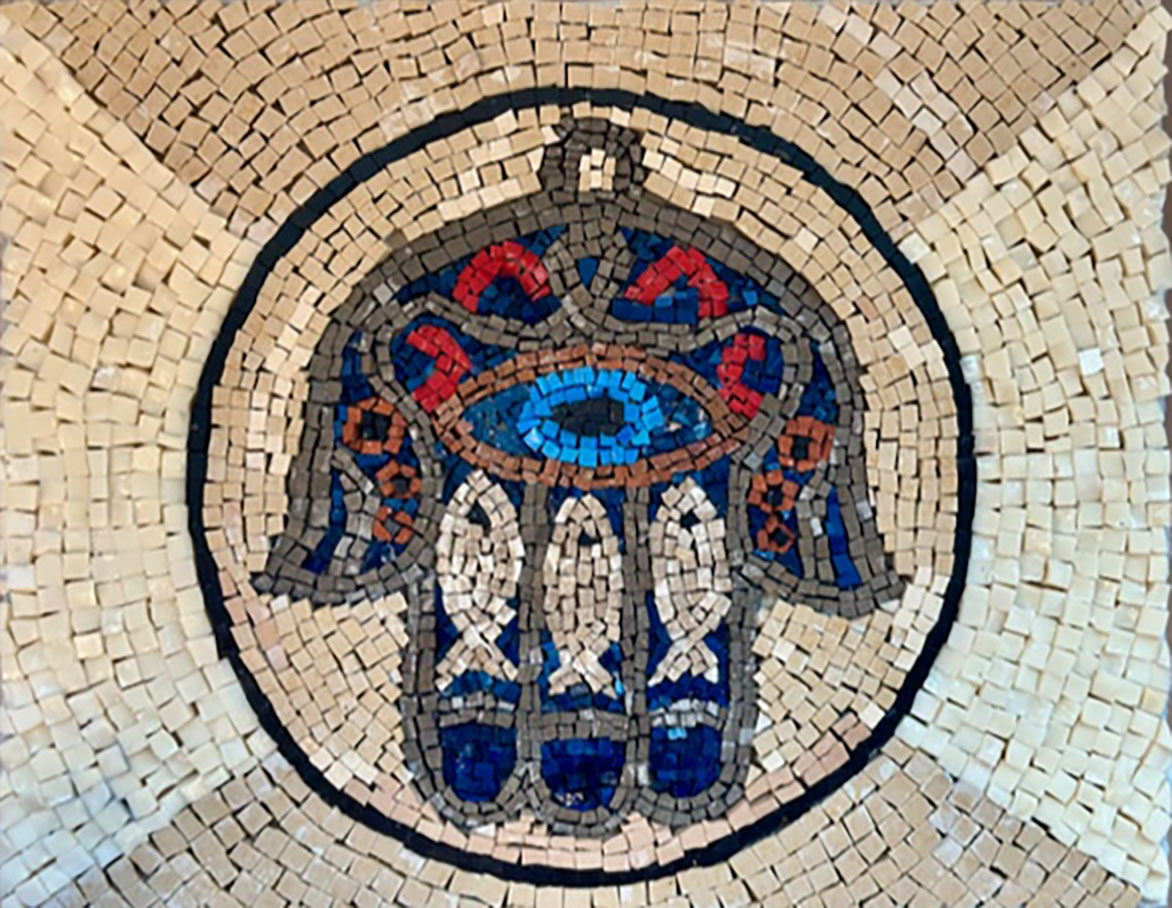Artist Bonnie Eisner emailed me a photo of her Hansa (Hand of Fatima) mosaic in progress because we were out of the color she wanted to use for the whole background.
My solution to the shortage was to take the problem as an opportunity to enhance the design by using andamento, color variation, and pattern in some way that relates to the figure in center.
I think Bonnie made great use of the advice. The color pattern creates lines of sight that lead the eye into the central figure, and the concentric andamento echoes the shape of the figure’s outline throughout the background.
The concentric andamento was actually easier to implement than a “simple” rectilinear grid, which would have required cutting pieces to shape where they intersected the central figure.
I think this mosaic is a great illustration for talking about why artists should think of backgrounds as an opportunity to improve the composition as a whole and why mosaic artists tend to rush through this part of the process.

Why Rush?
The difference between a mediocre work of art and a great work of art is just a few details.
The most satisfying part of the creative process is tweaking the details to make the art better than it might of been.
Why then do we rush to complete our mosaics at just the point when we should be working more slowly and looking critically at the details?
Workplace Mentality
The obvious answer is that mosaic takes more time than painting, drawing, and other mediums of visual art, but that can’t be the full answer.
After all, people screw up paintings for the same reason, and it’s possible to paint a great painting in only a matter of hours.
The problem isn’t the extra time that making a mosaic requires.
The problem is that much of our culture is defined by the corporate workplace, and so there is an artificial and pervasive need to always be showing progress in the form milestones and completed projects.
There are ways to sabotage these dysfunctional impulses, and I will write about that below, but first I wanted to discuss the specific situation where these impulses are most painfully felt in mosaic artwork: BACKGROUNDS.
Mosaic Backgrounds
Many mosaic artists and most novices complete their figures and fill in the background literally as an afterthought. That wouldn’t be a problem in itself if it weren’t for the rush to be done.
In fact, it makes sense in some situations to avoid committing to a particular background until you see how the figures turn out.
Working that way allows you to choose a background that adequately contrasts all elements of the figures, which might have required additional colors than originally thought necessary.
People are generally good at picking out a contrasting background color. In fact, they are so good at this that once they find the magic color, they ignore other concerns and fall victim to the “get ‘er done” mentality.
With the finish line in view, there is no thinking about how the background might be used to create additional visual interest.
There is only an irresistible urge to get done, usually by bricking the tiles in a thoughtless grid that has no relationship to the andamento used in the figures.
The results can look factory produced, as if the mosaic was made by an hourly employee trying to meet production quotas and not an artist trying to show us something interesting.
Improving Your Mosaic Art
Backgrounds should be thought of as opportunities to increase visual interest in your mosaic.
Of course there are situations where a background needs to simple and monochromatic.
When the figure is filigree, such a bare tree with many branches with slivers of background in between, then a relatively simple monochromatic background might be best.
When the figures are elaborately polychromatic, then a simple monochromatic background might be best.
The problem is that most novice mosaics aren’t like these situations. The figures in novice mosaics are often simple in shape with clear boundaries, solitary icons, and many of these compositions contain more background than figure.
In these situations, the mosaic cries out for a thoughtful background that increases the visual interest of the composition.
Before you lose yourself in the repetitive execution of tiling a background, spend some time thinking about the different ways you could use the background to improve the composition as a whole.
Think about patterning and andamento first, and then think about the polychromatic possibilities.
Even if your figure needs a background that is relatively simple, one that is nominally monochromatic, consider using two slightly different tints of the same hue.
For example, a simple blue sky is still a simple blue sky if it is tiled with two different tints of the same blue mixed together, but now it is less monotonous to the eye.
Justifying Your Existence
As mentioned above, our experiences in the workplace make us feel an artificial need to always be justifying our existence through tangible accomplishments.
This need is ingrained so deeply that affects non-work aspects of our lives and even projects where learning or experiencing something new is the main focus of the project.
You can short circuit the dysfunctional impulses in a variety of ways, and the first of these is merely being aware of the problem and stopping and thinking of the different possibilities.
The second is to take photos of the work in progress and use these as milestones to show people.
Photographing each stage teaches you many things including how to photograph artwork in the appropriate lighting.
It is also a way of forcing yourself to look at a thumbnail image of the mosaic, which helps you see it as a whole with fresh unbiased eyes.
The third way of deprogramming your need to rush is to work on more than one project at a time.
Each time you come back to a composition, you see it fresh again. You are also less emotionally obsessed with something if it isn’t the only thing you are working on. You see it more objectively.
The fourth way I avoid rushing is to look at previous work and notice simple things I wished I had done differently. Do I really need one more flawed composition sitting around my studio? Why can’t this next mosaic be a break-through piece with no regrets?
There is a Matisse quote that I am having trouble finding because it wasn’t inspirational or motivational tee-shirt material, but it was spot on about this issue.
In my garbled memory, the quote was something to the effect that the type of art Matisse created required lots of time for reflection.
Amen brother. You have to make haste slowly if you are trying to make Art with a capital A.


Leave a Reply